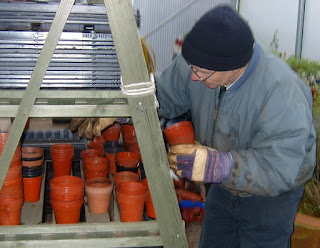Rosemary (Rosmarinis Officinalus) and Gilded Rosemary (Rosmarinis Offcinalus 'Veregatus').
Rosemary is for remembrance
Between
us day and night,
Wishing that I may always have
You present in
my sight.
Traditional Greek Ballad
 |
| Caption at Castle Bromwich Hall Gardens. |
Rosemary
is native to the Mediterranean. Found growing wild along cliffs, near the sea – it is an evergreen shrubby herb with
pungently aromatic leaves. John Evelyn the 17th century garden
writer reported that the perfume was so strong that it could be
detected 30 leagues off the coast of Spain.
Legend has it that the Virgin Mary
spread her cloak over a rosemary bush while she rested, and as a
result of this the flowers turned blue like her cloak. From then on,
the bush was called ‘Rose of Mary.”
Rosemary is
also known as ‘Sea rose, Herb of Crowns, Mary’s Tree,
Guardrobe, Incensier, Elf Leaf, Sea Dew, Dew of the Sea, Polar Plant,
Mary’s Cloak, Libanotis, Stella Maria, Star of The Sea, Compass
Weed and Compass Plant’.
The word ‘Rosmarinus’
comes from the Latin word ‘rosmaris’ which means
‘dew of the sea’, which is a reference to rosemary’s refreshing
effects on the spirit and the fact that rosemary’s habitat in the
Mediterranean is usually along the coastal regions.
 |
| Rosmarinus
officinalis – Kohler Medizinal-Pflanzen – 1897 - Public Domain |
The ancients knew
well of rosemary’s refreshing effects- ancient Greek students would
wear garlands of rosemary to increase their memory and this is how
rosemary became to be called the ‘Herb of Crowns.’
Rosemary has long been recognised as a symbol of remembrance, and an
example of its symbolic use today is seen at funerals where guests
wear a sprig of rosemary and a sprig of rosemary is also cast onto
the coffin of the deceased.
 |
Rosemary
(Rosmarinus Officinalis)
|
The ancients also used rosemary as a
respiratory ailment treatment and as sacred incense in some religious
ceremonies. Sprigs of rosemary have been found in Egyptian Tombs
(3000 BC.) It was the Arabs who first extracted the essential oil of
Rosemary. The Romans used rosemary to decorate statues of their
household Gods as rosemary symbolised stability.
The plant produces masses of powder blue flowers from early spring
to early summer, which are attractive to beneficial pollinators such
as bees – which is useful in a Kitchen Garden containing trained
fruit (espaliers, cordons and fans. The leaves on the Gilded Rosemary variety, as the name suggests, has a yellow gold-colour shot through the leaves.
 |
Rosemary
(Rosmarinus Officinalis)
|
 |
Gilded
Rosemary (Rosmarinus Offcinalis 'Veregatus')
|
Rosemary prefers a light soil. A sandy soil will fully satisfy its
meagre feeding needs. Rosemary is actually tolerant of most
soil conditions as long as they are not water-logged.
Rosemary also prefers a
slightly limey soil (the opposite of acid) because this results in
smaller plants with more fragrant leaves. True to its origins, rosemary will grow well in sunny and sheltered conditions. It will even stand severe frosts if
conditions are not windy and wet as well.
The ideal time to plant out rosemary is April.
Dig a hole in the soil slightly larger than the size as the pot. Add
1cm (half an inch) of sandy soil or sharp sand to the bottom of the
hole. Place the plant in the hole and fill around with a mix of half
sharp sand and half from the removed soil.
Rosemary does not like to have its roots disturbed, so leave as
much of the root ball undisturbed as possible. Water well if the
conditions are at all dry.
Rosemary requires very little care throughout the year.
Water only when the compost is clearly dried out and feed once a month
with liquid fertiliser from April to October. Trim the side stems to
keep the plant to the size you want, the best time to do this is just
after they have flowered. Cut back frost-damaged plants to healthy wood; straggley, old plants can be cut back hard at the same time. If the puning is neglected, hard wood will form from which new growth is impossible to emerge.
 |
Rosemary
(Rosmarinus Officinalis) with hard wood accumulation
|
Seeds are readily available from most major seed merchants. The seeds are cheap, although
propagation is erratic. Sow the seeds in potting
compost around
mid-May
time and place in a sheltered position in the
garden - be aware that you may only achieve a success rate of
about 15%. The seedlings may well take up to 2 months to appear so don't
give up hope until around 3 months have passed.
The best method of propagating Rosemary is by taking
cuttings,
mid-May
or
June
being the best time.Select a healthy looking plant with lots of
new growth on it. Use a sharp knife to take 7.5cm (3in) cutting from young shoots
either just below a leaf joint or torn off at the stem. If tearing off a
cutting, trim the "heel" to remove most, but not all of it. Strip of the leaves from the lower 4cm (1½in), pulling them off
with your fingers. Fill a 7.5cm (3in) pot with standard potting compost and insert
one or two cuttings in each pot. Water the compost from below and
place in a propagator or cover it with a plastic bag. A temperature of 15°C to 20°C (60°F to 70°F) is needed for the
cuttings to root. A windowsill out
of direct sunlight is an ideal position. They can be transplanted to
their permanent position when they have rooted, which will be in roughly
8 weeks.
Rosemary grows extremely well in large pots or other containers.
The pots need to be reasonably deep because rosemary is a deep rooting
herb. Fill the pot with a mixture of 20% sharp sand or grit and 80% standard potting compost.
Make a hole in the compost and place one rooted cutting
in the middle of the pot. Water the plant well to help it settle in and
consolidate the soil around the roots.
Container grown plants are more likely to affected by
severe frosts, so move the containers close to the house walls in
winter.
 |
Gilded
Rosemary (Rosmarinus Offcinalis 'Veregatus')
|
Pliny (23 - 79 AD), Dioscorides (contemporary of
Pliny and author of De Materia Medica a work on the use and
identification of medical herbs which was the basis of medical
practice for the next 1400 years), and Galin all wrote of rosemary.
It was cultivated by the Spanish in the 13th century and was a
popular condiment with salt meats from the 15th to 18th centuries.
Rosemary was often entwined into a wreath, dipped
in scented water and worn by brides at the alter. The wreath
symbolized fidelity, love, abiding friendship and remembrance of the
life the woman had led prior to her marriage.
The crowns and garlands of rosemary at weddings
led to the lays, or amorous ballads of the Troubadours (approx. 1100
- 1350) referring to rosemary as "Coronaria".
Anne of Cleves (1515 - 1557), Henry the Eighth's
4th wife, wore a rosemary wreath at their wedding. At that time,
wealthy bridal couples would also present a gilded branch of rosemary
to each wedding guest.
Newly
wed couples would also plant a branch of rosemary on their wedding day. If
the branch grew it was a good omen for the union and family. In ‘A
Modern Herbal’,
Mrs Grieves says “A
rosemary branch, richly gilded and tied with silken ribands of all
colours, was also presented to wedding guests, as a symbol of love
and loyalty.”
Another example of rosemary’s use as a love charm was that a young
person would tap another with a rosemary sprig and if the sprig
contained an open flower, it was said that the couple would fall in
love. Rosemary was used as a divinatory herb-several types of herbs
were grown in pots and assigned the name of a potential lover. Then
they were left to grow and the plant that grew the strongest and
fastest gave the answer. Rosemary was also stuffed into poppets
(cloth dolls) in order to attract a lover or attract curative
vibrations for illness. It was believed that placing a sprig of
rosemary under a pillow before sleep would repel nightmares, and if
placed outside the home it would repel witches.
 |
Rosemary
(Rosmarinus Officinalis)
|
Robert Hacket, in a wedding sermon in 1607 said,
"Let this Rosemarinus, this flower of men, ensigne of your
wisdom, love and loyaltie, be carried not only in your hands, but in
your heads and hearts." Herrick talks of rosemary's attachment
to both beginning and end of adult life with:
"Grow for two ends - it matters not at
all
Be't for my bridall, or my buriall."
In the 14th Century, rosemary root was "seethed
in wine vinegar" and the lotion was then used to wash the feet
of a thief. The lotion was thought to sap the strength of the robber
so that he would not longer commit robbery, steal or do any further
harm. In a humorous aside, our original source for this bit of
folklore questions their own source with, "How the potential or
suspected thief is to be persuaded to wash his feet, the manuscript
does not divulge."
The Countess of Hainault, Jeanne of Valois (1294 -
1342), sent her daughter Queen Phillippa (1311 - 1369), wife of King
Edward III of England (1312 - 1377), an accounting of the virtues of
rosemary and it is presumed a number of plants or cuttings
accompanied the gift. The original manuscript can be found in the
British Museum. The Countess suggests that laying the leaves under
the head of a man while he sleeps will "doth away evell
sprirites and suffereth not the dreeme fowl dremes ne to be afearde."
Bancke, in his work Herball from 1525,
suggests techniques to use rosemary as a remedy for both gout of the
legs and to keep the teeth from all evils. He also recommended that
smelling rosemary regularly would "keep thee youngly."
Gerard, author of Herball or Historie of
Plants(1597), referred to someone named Serapio who suggested
that a garland of rosemary worn about the head was a remedy for the
"stuffing of the head, that commeth through coldnes of the
brain." He also mentions that rosemary grew so plentifully in
Languedoc (a former province in south-eastern France) that "the
inhabitants burne scarce anie other fuel."
 |
Gilded
Rosemary (Rosmarinus Offcinalis 'Veregatus')
|
Rosemary was also believed to offer protection
from the plague. In 1603, when bubonic plague killed 38,000
Londoners, the demand was so high that the price increased from one
shilling for an armful to six shillings for a handful. To put that
price increase in perspective, one pricelist from 1625 indicated that
one could obtain 18 gallons of good ale or double beer with
carriage(delivery?) for only 3 shillings or an entire 'fat pig' for 1
shilling.
Richard Folkard, author of Plant Lore, Legends
and Lyrics, written in 1892, mentions that in Sicily, rosemary
was a favored plant and that "the young fairies, under the guise
of snakes, lie concealed under its branches."
Rosemary and thyme
were used on St. Agnes' Eve, an evening and day that honors St.
Agnes, the patron saint of virgins and young girls. St. Agnes' eve is
celebrated on January 20th and 21st. Wikipedia mentions some rituals
practiced on St. Agnes' Eve were to aid young girls in discovering
their future husbands, a superstition that was the main theme of John
Keat's poem, The Eve of Saint Agnes.
A common saying of rosemary was, "Where
rosemary flourishes the lady rules." According to the same
folklore, a man seeking relief of his lady's rule would find no
benefit from damaging or destroying a vigorous bush of rosemary.
 |
Rosemary
(Rosmarinus Officinalis)
|
Parkinson (1567-1650), the King's Botanist to
Charles I, mentions that in countries where rosemary is well-suited
and grows to a large size that thin boards of rosemary were used to
make lutes and other instruments, carpenters rules, and a myriad of
other implements. The French believed that combing their hair once a
day with a rosemary wood comb would prevent giddiness. Uncrupulous
merchants however, would often use other woods and simply scent them
with rosemary oil.
Shakespeare's (1564 - 1616) Ophelia says in
Hamlet, "There's rosemary, that's for remembrance. Pray
you, love, remember!" He also mentions how the English once
placed rosemary in coffins and around graves in Romeo and Juliet
when Father Lawrence says:
"Dry up your tears, and stick your
Rosemary
On this fair corse."
There was a bit of disagreement within our sources
as to the reason rosemary was often placed with corpses at burial.
Most linked its usage to being a plant associated with remembrance.
One source, Herbal Simples Approved for Modern Uses of Cure,
believed the custom stemmed from a much more practical application.
It was thought that the smelling of rosemary provided a powerful
"defence against any morbid effluvia from the corpse." In
other words, rosemary was used by mourners to provide relief from the
odor of decomposition.
With perhaps some reference to fidelity and his
lack thereof, a soldier shot in 1649 for mutiny was buried with
rosemary. His body was adorned with branches of rosemary but half of
each branch had been stained with blood.
Queen Elizabeth was fond of mead and her own
recipe for the drink included the leaves of sweet briar, with
rosemary, cloves and mace. (Unfortunately, our source failed to
identify which Queen Elizabethe they were talking about.)
French hospitals, at one time, burned Juniper
berries with rosemary to correct vitiated or poor quality air and to
prevent infection. Additionally, in the French language of flowers,
rosemary represents the power of rekindling lost energy.
Rosemary was once used to create Essence of
Mustard which also included spirits of turpentine and black mustard
seed. The resulting oil was not prone to going rancid and was used by
clockmakers and for other "instruments of precision."
In Spain, rosemary was used as a protection
against witchcraft and menaces on the road. George Borrow mentioned
how he came to learn about this superstition in his work The Bible
in Spain (1843). He first mentions meeting a traveler who had
adorned his hat with rosemary and later mentions a lady, who
concerned for Borrow's own safety, offered him some for his own hat.
Despite the promised protection provided by the Rosemary, Borrow met
with a series of misfortunes on his journey. He contemplates a return
visit to the lady to inform her of the failure of the protective
abilities of rosemary.
An old Spanish proverb says of rosemary that men
who are indifferent to the scent of rosemary are likely to be
insensitive about other pleasures:
...Who passeth by the rosemarie
And
careth not to take a spraye
For woman's love no care has he,
Nor
shall he though he live for aye...
In
1235, The Queen of Hungary became paralysed and legend has it that a
hermit soaked a pound of rosemary in a gallon of wine for several
days and then rubbed it on her limbs. This treatment cured the Queen
Elizabeth of Hungary of her paralysis, and the rosemary-wine
combination became known as ‘Queen
of Hungary’s Water.’
This concoction was used for centuries to treat dandruff, gout, skin
problems and to prevent baldness.
 |
Rosemary
(Rosmarinus Officinalis) - Unknown Italian Artist - circa. 1500 - Public Domain
|
The
French hung rosemary in hospitals and sickrooms as healing incense.
It was referred to as ‘incensier.’
Rosemary was the favourite scent of Napoleon Bonaparte.
How to make Rosemary Sugar:
Clean and dry
well several sprigs of fresh rosemary. Place in a canister or
srew-topped jar and cover with 1 lb of sugar. Shake well and leave to
stand for 24 hrs. Shake well again and leave to stand for several days.
Remove the sprigs of rosemary and the sugar is ready for use in milk
puddings, egg custards etc.
Gilded Rosemary can be found at Castle Bromwich Hall Gardens in the edge-beds alongside the Batty Langley Kitchen Garden.
Rosemary (Rosmanus Officinalus) can be found at very points in the Gardens, so have fun looking for it!
This article has been fabricated from several sources to who grateful thanks are due:
Thanks are also due to:
- Gordon Sammons
- Chris Hitchcock
- Brian Jennings
All photographs (unless credited elsewhere) are by Yvonne High, and are licensed under a
Creative Commons Attribution-NonCommercial 2.0 UK: England & Wales License





 ,
,

 ,
,



















